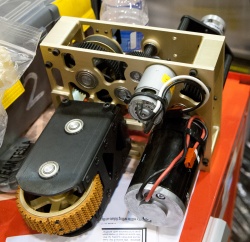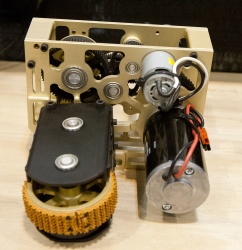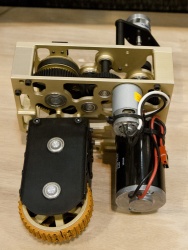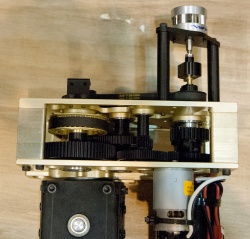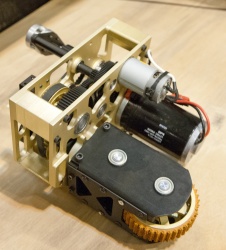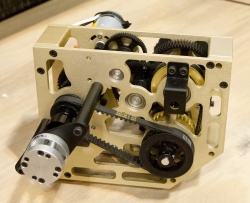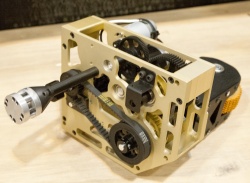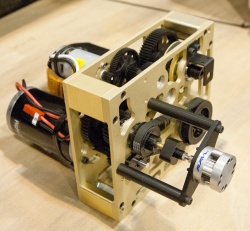Difference between revisions of "DEWBOT VIII Drive-train Team Page"
MaiKangWei (talk | contribs) (→FRC Team 1717's awesome pivots) |
(1717 details, 2009-2012) |
||
| Line 16: | Line 16: | ||
==FRC Team [http://www.dpengineering.org/1717/welcome 1717's] awesome pivots== | ==FRC Team [http://www.dpengineering.org/1717/welcome 1717's] awesome pivots== | ||
| − | Team 1640 is generally considered a competent | + | Team 1640 is generally considered a competent practitioner of pivot (a.k.a swerve, unicorn,...) drive. I was, however, humbled when I saw team [http://www.dpengineering.org/1717/welcome 1717's] (D'Penguineers) pivot module at St. Louis. More so afterwards when I [http://www.youtube.com/playlist?list=PL51FE6FC40790DD2B watched videos] of how they move. If we ue Pivot again, we've got a new performance target. My photos from Championships are below (original 4368 x 2912 pixel photos are available upon request). |
<gallery widths=250 heights=250 perrow=3> | <gallery widths=250 heights=250 perrow=3> | ||
Image:1717_Pivot_120426_csm-1.jpg| | Image:1717_Pivot_120426_csm-1.jpg| | ||
| Line 35: | Line 35: | ||
There appears to be seven (7) discrete vertical axles in the module (supporting two drive trains - wheel drive & steering). There are two parallel horizontal axles in the pivot (wheel drive). Two vertical module axles contain coaxial elements (the gear shift and the pivot itself). Instrument take-offs are provided for CIM motor speed (not reduced) and pivot angle. | There appears to be seven (7) discrete vertical axles in the module (supporting two drive trains - wheel drive & steering). There are two parallel horizontal axles in the pivot (wheel drive). Two vertical module axles contain coaxial elements (the gear shift and the pivot itself). Instrument take-offs are provided for CIM motor speed (not reduced) and pivot angle. | ||
| − | Gear shift with independent pivot drive is very cool and probably useful under many conditions. By taking much of the drive reduction with gears, a smaller difference between drive & driven pulleys are needed. | + | Gear shift with independent pivot drive is very cool and probably useful under many conditions. By taking much of the drive reduction with gears, a smaller difference between drive & driven pulleys are needed. |
| + | |||
| + | ===1717's Awesome Pivots' History=== | ||
| + | ''Thanks be to Jake in response to Siri. (CD)''<br> | ||
| + | ;2009 - Coupled Drive, CIM+Belt & 545s | ||
| + | :This was the first year that we decided to use a swerve drivetrain. Our drivetrain was split down the middle of the robot. On the left side, both of the drive wheels were paired together and powered by 1 CIM motor through a single speed belt reduction that used timing pulleys. The left wheels were also paired together for turning. The turning was powered by a Banebots RS-545 though a Banebots planetary transmission. | ||
| + | :The right side of the robot was a mirror image of the left side. | ||
| + | |||
| + | ;2010 - Coupled Drive, CIM+Supershifter & 545s | ||
| + | :The drive for the wheels were again coupled together in pairs. Both of the left wheels were driven together and both of the right wheels were driven together. To power this drive, each pair of wheels was powered by two CIM motors through a two-speed transmission that was a re-packaged AM Supershifter gear-set with some custom modifications. | ||
| + | :For turning, the front left and back right wheels were paired together and the front right and back left wheels were paired together. This enabled both translational motion in any direction and rotation of the robot about its origin when it was not translating. Each turning pair was powered by a single fisher price motor through our custom gearbox with purchased gears. | ||
| + | |||
| + | ;2011 - Coupled Drive, CIM+Custom Shifters & 775s | ||
| + | :The wheel pairings were the same as in 2010, but the turning motors were Banebots RS-775 motors. | ||
| + | :Our drive transmissions were custom two-speed transmissions that were optimized for our swerve system. The turning transmissions were custom as well. Also, we cut all of our gears in house and they were made from steel. | ||
| + | |||
| + | ;2012 - Unicorn Drive, CIM+Custom Shifters & 550s | ||
| + | :In 2012, our drivetrain consisted of four independent wheel modules. Each wheel module’s drive was powered by one CIM motor with a two-speed custom gearbox. Our wheel modules' turning was powered by a single Banebot RS-550 with a custom transmission. All of our gears were made from aluminum and they were cut in house. | ||
---- | ---- | ||
[[Category:DEWBOT VIII]] | [[Category:DEWBOT VIII]] | ||
Revision as of 11:52, 25 June 2012
Student Lead: Molly
Head Mentor: Ben Kellom
Students:
Mentors:
Contents
Pivot drive Steering Motor selection
The BaneBots RS540 motors used in 2011 are not available for the 2012 robot. Alternatives are BaneBots RS395 and BaneBots RS550 motors. After analysis, BaneBots RS395 motors with 132:1 reduction were selected, primarily based on their lower contribution to robot mass.
Motor/Gearbox for Barrier crossing
Early prototype testing using DEWBOT VI demonstrated that raised, 8" diameter KitBot wheels are incapable of allowing a pivot drive chassis being driven over the mid-field barrier. An alternative is the use of driven, 8" diameter pneumatic wheels. What motors & gearboxes are needed to drive these wheels? Analysis indicates that FisherPrice motors and Gearbox's will do the job (one should alone, in fact, if the power transmission to the two wheels is managed).
FRC Team 1717's awesome pivots
Team 1640 is generally considered a competent practitioner of pivot (a.k.a swerve, unicorn,...) drive. I was, however, humbled when I saw team 1717's (D'Penguineers) pivot module at St. Louis. More so afterwards when I watched videos of how they move. If we ue Pivot again, we've got a new performance target. My photos from Championships are below (original 4368 x 2912 pixel photos are available upon request).
While the 1717 pivot module design is mechanically impeccable (albeit at 9 lbm a bit heavier than ours), the videos make it crystal clear that their primary benefit comes from control and software, not mechanics.
D'Penguineers, of course, were made famous by Neal Bascomb's book, The New Cool, Crown Publishers (2011).
From the photos, I deduce that 1717 has discrete left & right pivot modules. Top module plates (at least) appear to be machined left-right specific.
There appears to be seven (7) discrete vertical axles in the module (supporting two drive trains - wheel drive & steering). There are two parallel horizontal axles in the pivot (wheel drive). Two vertical module axles contain coaxial elements (the gear shift and the pivot itself). Instrument take-offs are provided for CIM motor speed (not reduced) and pivot angle.
Gear shift with independent pivot drive is very cool and probably useful under many conditions. By taking much of the drive reduction with gears, a smaller difference between drive & driven pulleys are needed.
1717's Awesome Pivots' History
Thanks be to Jake in response to Siri. (CD)
- 2009 - Coupled Drive, CIM+Belt & 545s
- This was the first year that we decided to use a swerve drivetrain. Our drivetrain was split down the middle of the robot. On the left side, both of the drive wheels were paired together and powered by 1 CIM motor through a single speed belt reduction that used timing pulleys. The left wheels were also paired together for turning. The turning was powered by a Banebots RS-545 though a Banebots planetary transmission.
- The right side of the robot was a mirror image of the left side.
- 2010 - Coupled Drive, CIM+Supershifter & 545s
- The drive for the wheels were again coupled together in pairs. Both of the left wheels were driven together and both of the right wheels were driven together. To power this drive, each pair of wheels was powered by two CIM motors through a two-speed transmission that was a re-packaged AM Supershifter gear-set with some custom modifications.
- For turning, the front left and back right wheels were paired together and the front right and back left wheels were paired together. This enabled both translational motion in any direction and rotation of the robot about its origin when it was not translating. Each turning pair was powered by a single fisher price motor through our custom gearbox with purchased gears.
- 2011 - Coupled Drive, CIM+Custom Shifters & 775s
- The wheel pairings were the same as in 2010, but the turning motors were Banebots RS-775 motors.
- Our drive transmissions were custom two-speed transmissions that were optimized for our swerve system. The turning transmissions were custom as well. Also, we cut all of our gears in house and they were made from steel.
- 2012 - Unicorn Drive, CIM+Custom Shifters & 550s
- In 2012, our drivetrain consisted of four independent wheel modules. Each wheel module’s drive was powered by one CIM motor with a two-speed custom gearbox. Our wheel modules' turning was powered by a single Banebot RS-550 with a custom transmission. All of our gears were made from aluminum and they were cut in house.
